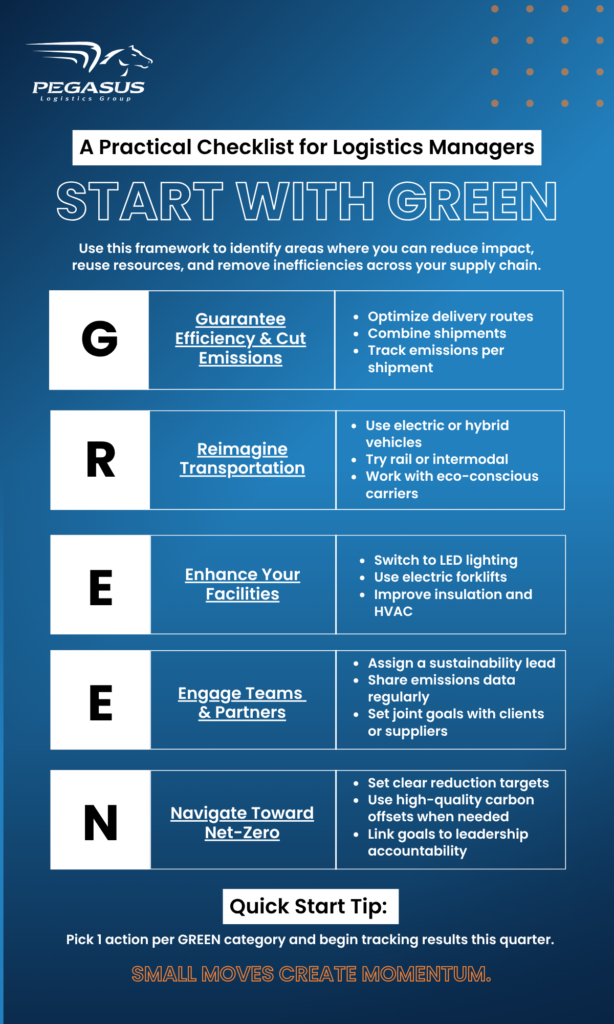Sustainability is becoming one of the most important conversations in logistics. With growing pressure from customers, regulators, and global events, companies are reevaluating how freight moves, how warehouses operate, and how to reduce their impact on the environment. But beyond responsibility, there’s also opportunity.
In this guide, you’ll learn how to start, where to focus, and what actions are already making a difference across the industry.
Table of Contents
The Business Case for Sustainability in Logistics
Many people think of sustainability as something nice to have. But for logistics, it is fast becoming a core requirement for long-term success. A growing number of companies are realizing that their survival depends on how they respond to environmental pressures.
“If we look at the condition of the world, we need clean air, healthy people, and functioning communities. Business depends on the carrying capacity of the planet not being overrun.” Phil Clawson, Global Head of Sustainability at Pegasus Logistics Group, explained.
That’s why sustainability in logistics is not just about environmental responsibility. It is about business resilience. Logistics accounts for up to ten percent of global emissions. With freight demand expected to triple by 2050, the industry has a responsibility to act.
Core Strategies for Green Logistics and Supply Chain Decarbonization
Foundational Efficiencies
The core strategies for green logistics focus on two main areas that are crucial for supply chain decarbonization: improving foundational efficiency and embracing innovation. This means reducing unnecessary trips, shortening routes, and improving the way goods are packed and transported. Simple changes such as optimizing delivery routes or consolidating shipments can have an immediate effect on emissions and profitability.
“One big piece is about driving efficiency,” said Clawson. “It lowers costs as well as lowering impact.”
Warehousing also plays a critical role. Upgrades like LED lighting, electric forklifts, and better insulation reduce the energy needed to operate facilities.
Innovations in Action
While efficiency delivers results quickly, it only goes so far. For deeper impact, companies must adopt new technologies and fuels. We are already investing in renewable diesel, sustainable aviation fuel, and battery electric vehicles.
“Sustainability is a great tool to unlock innovation,” Clawson noted. “It makes you think creatively.”
One example is the electrification of a cross-border route from Juarez to El Paso. Trucks on that route often idle for long periods, creating both carbon emissions and poor air quality. By switching to electric vehicles, Pegasus Logistics Group is helping reduce pollution and improve the health of surrounding communities.
Practical Checklist for Logistics Managers
To help you identify which strategies can deliver the greatest impact for your operations, we’ve created a practical, step-by-step guide you can download and use to map out your own transition to greener logistics smoother, faster, and more effective.

The Financial Equation: Is a Sustainable Supply Chain Profitable?
Some believe that going green means higher costs. But that assumption doesn’t hold up under real-world analysis. Many sustainable practices actually lower expenses, especially when viewed over time.
“It’s a very easy win for the planet, for people, and for companies,” said Clawson. “You remove inefficiencies and that saves money.”
In cases where new investments are needed, the long-term return often outweighs the upfront cost. For instance, using electric vehicles may involve higher capital costs, but the reduced fuel and maintenance expenses add up over time.
Partnering for a Sustainable Logistics and Supply Chain Future
While internal improvements are important, the biggest opportunities come from working together. We believe that partnerships with clients, suppliers, and peers are essential to creating large-scale impact.
“We have to walk the talk ourselves,” said Clawson. “But there’s limited impact if we only look within our four walls.”
By working with sustainability leads in procurement or corporate responsibility teams, logistics providers can help clients reach their environmental goals. These partnerships also open the door to shared innovation and shared investment. When companies align on values and outcomes, sustainability becomes a collective success.
Ready to build a smarter, more sustainable supply chain? Contact us today to start the conversation.
